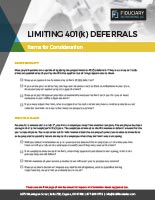
The Story
Dorsey’s Dental Practice has a 401(k) plan. Dr. Dorsey signed up to defer 10% of his compensation each pay period, half of which is to be pre-tax and half of which is to be Roth. He is currently 46 years old, so the most he can save to the plan this year is $18,000. His anticipated wages for the year are $260,000.
Doris at Dr. Dorsey’s office runs payroll for the practice every other week. One day, late of the year, she runs a report on the year to date 401(k) contributions and notices that Dr. Dorsey has managed to defer $20,000 so far between pre-tax and Roth. Doris knows this is incorrect so she contacts her payroll company. It turns out there is a field in the payroll system that must be turned to yes in order to add the pre-tax and the Roth 401(k) together for purposes of the limit. That field wasn’t turned to yes in Doris’ system.
How did they fix it?
To correct the error, Doris fixed the field in her payroll system. She also instructed her service provider team to return the extra $2,000 that had been deposited to the plan to Dr. Dorsey, adjusted for earnings. There was no need to file anything with the IRS as Doris corrected the error before April 15th of the year following the year in which the error occurred.
What about other mistakes?
After going through the correction for this mistake, Dr. Dorsey became concerned that other errors might be occurring in his plan. He has a small business, so he didn’t want a full outsourced Plan Administrator. However, he did want someone who would oversee payroll, sign his 5500 filings and approve his loans and distributions. He decided these were the areas with the most risk for him. Ultimately, he selected Fiduciary Outsourcing as his outsourced fiduciary solution to meet his needs.

The Mistake
The IRS imposes a limit on how much an employee can defer in a year. For those employees not yet age 50, the limit is the lesser of $18,000 or 100% of the employee’s gross compensation. For those employees who are age 50 or over, the limit is the lesser of $24,000 or 100% of the employee’s gross compensation. The limit is based on the individual employee’s personal tax year which is usually the calendar year. And, the limit changes each year for cost of living and is published late in October each year for the upcoming year.
From time to time, employee deferrals during a year exceed these limits. Perhaps someone overrode the limit in the payroll system. Perhaps the payroll system wasn’t set up to add all types of employee deferrals together to check the limit.

What Happens
The IRS says that if you discover the error by April 15th of the next year, you can simply return the extra money with appropriate earnings to the employee.
Avoid it
You must rely on your payroll system to catch this error. You should confirm with your payroll provider that their system can properly limit 401(k) deferrals. You should confirm that the system actually is set up to limit deferrals properly. You should confirm the limit works by aggregating the pre-tax and Roth deferrals together before applying the limit.
The best practice would be to audit the payroll system periodically to ensure the limit on deferrals is being applied correctly.

How We Help
You have the ability to outsource your responsibilities as the Plan Administrator. As such, you can outsource the responsibility to audit your payroll system to make sure it is coded properly. You can also outsource your ability to audit reports periodically to ensure that this limit isn’t being exceeded.

The Story
Dorsey’s Dental Practice has a 401(k) plan. Dr. Dorsey signed up to defer 10% of his compensation each pay period, half of which is to be pre-tax and half of which is to be Roth. He is currently 46 years old, so the most he can save to the plan this year is $18,000. His anticipated wages for the year are $260,000.
Doris at Dr. Dorsey’s office runs payroll for the practice every other week. One day, late of the year, she runs a report on the year to date 401(k) contributions and notices that Dr. Dorsey has managed to defer $20,000 so far between pre-tax and Roth. Doris knows this is incorrect so she contacts her payroll company. It turns out there is a field in the payroll system that must be turned to yes in order to add the pre-tax and the Roth 401(k) together for purposes of the limit. That field wasn’t turned to yes in Doris’ system.
How did they fix it?
To correct the error, Doris fixed the field in her payroll system. She also instructed her service provider team to return the extra $2,000 that had been deposited to the plan to Dr. Dorsey, adjusted for earnings. There was no need to file anything with the IRS as Doris corrected the error before April 15th of the year following the year in which the error occurred.
What about other mistakes?
After going through the correction for this mistake, Dr. Dorsey became concerned that other errors might be occurring in his plan. He has a small business, so he didn’t want a full outsourced Plan Administrator. However, he did want someone who would oversee payroll, sign his 5500 filings and approve his loans and distributions. He decided these were the areas with the most risk for him. Ultimately, he selected Fiduciary Outsourcing as his outsourced fiduciary solution to meet his needs.

The IRS imposes a limit on how much an employee can defer in a year. For those employees not yet age 50, the limit is the lesser of $18,000 or 100% of the employee’s gross compensation. For those employees who are age 50 or over, the limit is the lesser of $24,000 or 100% of the employee’s gross compensation. The limit is based on the individual employee’s personal tax year which is usually the calendar year. And, the limit changes each year for cost of living and is published late in October each year for the upcoming year.
From time to time, employee deferrals during a year exceed these limits. Perhaps someone overrode the limit in the payroll system. Perhaps the payroll system wasn’t set up to add all types of employee deferrals together to check the limit.

What Happens
The IRS says that if you discover the error by April 15th of the next year, you can simply return the extra money with appropriate earnings to the employee.
Avoid it
You must rely on your payroll system to catch this error. You should confirm with your payroll provider that their system can properly limit 401(k) deferrals. You should confirm that the system actually is set up to limit deferrals properly. You should confirm the limit works by aggregating the pre-tax and Roth deferrals together before applying the limit.
The best practice would be to audit the payroll system periodically to ensure the limit on deferrals is being applied correctly.

How We Help
You have the ability to outsource your responsibilities as the Plan Administrator. As such, you can outsource the responsibility to audit your payroll system to make sure it is coded properly. You can also outsource your ability to audit reports periodically to ensure that this limit isn’t being exceeded.


